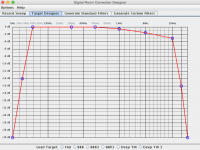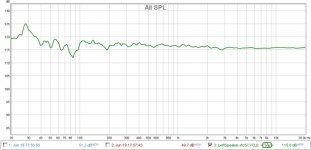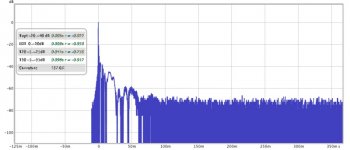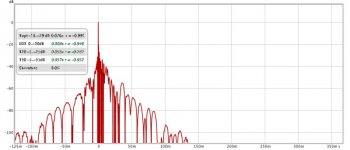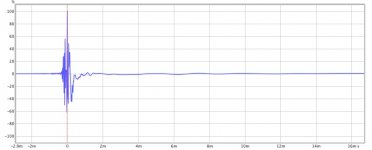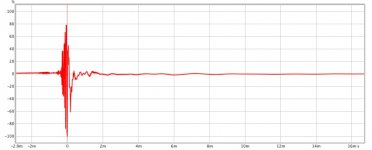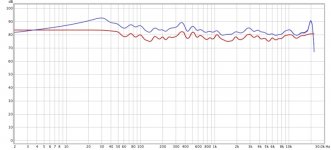I know that happened to me a couple of times. Right now if I really enjoy the sound I get I rename the filter to the settings I used in DRC Designer and include an image of my target curve under the same name.
Yes, I still use DRC Designer. With a template based on Greg's set posted in the first post of this thread copied as soft44100.drc. I changed a couple of things though after some experimenting with previews of the results in REW.
I'll upload it for people to try it...
This isn't a linear phase template though, this is minimum phase all the way and should work fine for single full range speakers.
I just tried getting a filter with the template you provided, but it does not generate a filter. It just goes quickly through the Status messages and stops.
Hi, perceval:
Try this filter and let us know how it sounds. This was done with the 4 cycles configuration and according to the outline the guide. Although these measurements (hopefully they were the correct ones) are cleaner than what I saw a while back, they are still not quite clean enough to allow DRC to automatically identify the impulse center (right channel) and this needed to be done manually.
Try this filter and let us know how it sounds. This was done with the 4 cycles configuration and according to the outline the guide. Although these measurements (hopefully they were the correct ones) are cleaner than what I saw a while back, they are still not quite clean enough to allow DRC to automatically identify the impulse center (right channel) and this needed to be done manually.
Attachments
Had a quick listen to both your templates.
Did you high pass anything when you made the template? There's not much in the lower frequencies. There's a little loss of presence compared to my filter, but the spatial clues were pretty much dead on.
My filter is a little darker, but it works well, as the W8-1772 are pretty bright to start up with (no BSC). I also have a tiny boost around 1.5kHz, as wesayso mentioned in another thread, to add a little sparkle, but forgot to turn it off when I listened to your templates.
I'll go back to listening later!
BTW, this is the target curve I play with at the moment
Did you high pass anything when you made the template? There's not much in the lower frequencies. There's a little loss of presence compared to my filter, but the spatial clues were pretty much dead on.
My filter is a little darker, but it works well, as the W8-1772 are pretty bright to start up with (no BSC). I also have a tiny boost around 1.5kHz, as wesayso mentioned in another thread, to add a little sparkle, but forgot to turn it off when I listened to your templates.
I'll go back to listening later!
BTW, this is the target curve I play with at the moment
Attachments
Last edited:
Did you high pass anything when you made the template? There's not much in the lower frequencies. There's a little loss of presence compared to my filter, but the spatial clues were pretty much dead on.
My filter is a little darker, but it works well, as the W8-1772 are pretty bright to start up with (no BSC). I also have a tiny boost around 1.5kHz, as wesayso mentioned in another thread, to add a little sparkle, but forgot to turn it off when I listened to your templates.
I'll go back to listening later!
BTW, this is the target curve I play with at the moment
Are you referring to gmad's filter or did you play around with my template as well? My template might give less boost as it has a dip limiter engaged.
But to call this a high pass would be taking tings to far
An externally hosted image should be here but it was not working when we last tested it.
The dip limiter will prevent boosting deep dips.
DLMinGain = 0.2 #
In the original template the DLMinGain = 0.01. The plot above is made with the template I uploaded. You could try to set DLMinGain to 0.1 which corresponds to -20 dB. I don't want narrow dips being boosted because that could make the sound more strained. But it can effect the boosting of the highs and lows past their natural curve.
You can play with all parameters in the custom tab with my template. And use that target curve.
Had a quick listen to both your templates.
Did you high pass anything when you made the template? There's not much in the lower frequencies. There's a little loss of presence compared to my filter, but the spatial clues were pretty much dead on.
My filter is a little darker, but it works well, as the W8-1772 are pretty bright to start up with (no BSC). I also have a tiny boost around 1.5kHz, as wesayso mentioned in another thread, to add a little sparkle, but forgot to turn it off when I listened to your templates.
I'll go back to listening later!
BTW, this is the target curve I play with at the moment
If you're referring to my filter, it is giving a flat response with no highpass. Most people seem to perceive a response like this at the listening position as either "bright" or "lean" or both. It works for me, but I sit close to the speakers and have a nicely behaved room. Can you run two convolvers back to back? If so, I could just send you the IR of your chosen target response. Otherwise, when I have more time, I'll make you another filter. It does sound like we're on the right track though.
My room is far from being behaved! 
I am not sitting close to my speakers, and I have to take into considerations that my room is a big cement rectangle. It's a bit of a mess, but with some tweaking, it can be a reasonably enjoyable listening experience.
I could have another VST thrown in there while using JRiver, but I'm afraid of the trouble it might induce... and the added layers of tweaks.
We are doing great, and my system has never sounded so good, whether from your cleaner filters or my more bass immersive filters (still, not Dr Dre Beats style bass heavy, those things are terrible!). Like I mentioned, my TBs are pushing the highs pretty hard, so having a little emphasis on the lower mid range just balances things out
I'm in no hurry. I'm enjoying the sounds right now. I'll play with wesayso's template a little and see if I can extract a little more oomph from it.
Have a great weekend... Dragon Boat weekend here. For me, that means a 4-day weekend! yeah!
I am not sitting close to my speakers, and I have to take into considerations that my room is a big cement rectangle. It's a bit of a mess, but with some tweaking, it can be a reasonably enjoyable listening experience.
I could have another VST thrown in there while using JRiver, but I'm afraid of the trouble it might induce... and the added layers of tweaks.
We are doing great, and my system has never sounded so good, whether from your cleaner filters or my more bass immersive filters (still, not Dr Dre Beats style bass heavy, those things are terrible!). Like I mentioned, my TBs are pushing the highs pretty hard, so having a little emphasis on the lower mid range just balances things out
I'm in no hurry. I'm enjoying the sounds right now. I'll play with wesayso's template a little and see if I can extract a little more oomph from it.
Have a great weekend... Dragon Boat weekend here. For me, that means a 4-day weekend! yeah!
This is good stuff, gmad, Greg (is it?). I tried it yesterday and it did clean up the sound nicely. In the past, I have made measurements and corrected the HF response and also the LF response. But it is always hard to correct the response from 100 Hz to about 300 Hz. I have never been able to satisfactorily correct this range. But the sliding window plus auto correction that DRC offers seems to really benefit this area. Most of the voice fundamentals and instrument fundamentals are in this range.
I tried the 5 cycles filter and here is the response I am seeing (from the test.bat output). Crossover to the sub is right around 80-90 Hz. And I had some corrections in JRiver turned on when I did the measurement. What I perceive is lack of upper bass, but lowest frequencies (<40 Hz) are well reproduced. Low male vocals are excellent, which tells me that 100 Hz onwards is also good. It is also a little bright in the HF, but very smooth, i.e., no resonances. Does the soft template target a shelved HF response? I think this is what is needed when I'm measuring in the far field.
How do you create a target that gives a 6-10 db bumped up response from about 100 Hz to 50 Hz and then a slight roll off to 20 Hz?
I'll try some other filters too. I'm interested in what the ERB filter does. Your guide really helped getting things started. So, thanks!
I tried the 5 cycles filter and here is the response I am seeing (from the test.bat output). Crossover to the sub is right around 80-90 Hz. And I had some corrections in JRiver turned on when I did the measurement. What I perceive is lack of upper bass, but lowest frequencies (<40 Hz) are well reproduced. Low male vocals are excellent, which tells me that 100 Hz onwards is also good. It is also a little bright in the HF, but very smooth, i.e., no resonances. Does the soft template target a shelved HF response? I think this is what is needed when I'm measuring in the far field.
How do you create a target that gives a 6-10 db bumped up response from about 100 Hz to 50 Hz and then a slight roll off to 20 Hz?
I'll try some other filters too. I'm interested in what the ERB filter does. Your guide really helped getting things started. So, thanks!
Attachments
Last edited:
Glad you're having fun with DRC. If you like the ERB template it is a bit different from the others in windowing. Quite loose in the bass, a bit longer up top.
There are so many variables to play with that I haven't reached the end settings yet. You can mold it to your own likings...
There are so many variables to play with that I haven't reached the end settings yet. You can mold it to your own likings...
Hi, ra7:
I'm glad to hear that things are working out. Be aware that there are several differences between my configuration files (Xcycles-44.1.drc) and the standard files. I have attached a new erb config file reflecting these changes. Any difference you hear now should be due to the difference in windowing.
**you must change the extension from .txt to .drc**
I'm glad to hear that things are working out. Be aware that there are several differences between my configuration files (Xcycles-44.1.drc) and the standard files. I have attached a new erb config file reflecting these changes. Any difference you hear now should be due to the difference in windowing.
**you must change the extension from .txt to .drc**
Attachments
Hi guys, sorry for being so late in replying. We had a long weekend with the Dragon Boat Festival here.
Got to listen to the new B&K filter and it is very close to my custom filter. Differences being that Greg's filter is more focused and a little more clinical with the experience. My custom is a bit wider and has a little more lower mid range, giving it a warmer presence.
I imported both filters into REW to take a look. My custom (blue) versus Greg's (red) has a big boost at 30Hz and a spike at 20Hz. I have no idea how they got there since that was not the target response I drew up. Don't care about the 20Hz as I can't hear it, but I definitely hear the lower boost.
Otherwise, it follows pretty much all the way through.
The big differences are in the Filtered IR plots. Greg's looks great, mine... hmmm...
And finally, a little question.... what do you mean by B&K? Looked it up but didn't come up with anything... and since I do not like not knowing things... I had to ask!
Got to listen to the new B&K filter and it is very close to my custom filter. Differences being that Greg's filter is more focused and a little more clinical with the experience. My custom is a bit wider and has a little more lower mid range, giving it a warmer presence.
I imported both filters into REW to take a look. My custom (blue) versus Greg's (red) has a big boost at 30Hz and a spike at 20Hz. I have no idea how they got there since that was not the target response I drew up. Don't care about the 20Hz as I can't hear it, but I definitely hear the lower boost.
Otherwise, it follows pretty much all the way through.
The big differences are in the Filtered IR plots. Greg's looks great, mine... hmmm...
And finally, a little question.... what do you mean by B&K? Looked it up but didn't come up with anything... and since I do not like not knowing things... I had to ask!
Attachments
B&K = bruel & kjaer. Read this paper. Figure 5 is what you want.
http://www.bksv.com/doc/17-197.pdf
Essentially, when you are in the far field, you need a bass boost between about 40 Hz to 100 Hz and then flat to about 400 Hz and then a shelved down response. The amount of shelving depends on the directivity of your speakers, your listening position relative to the speakers and the room abosrption.
http://www.bksv.com/doc/17-197.pdf
Essentially, when you are in the far field, you need a bass boost between about 40 Hz to 100 Hz and then flat to about 400 Hz and then a shelved down response. The amount of shelving depends on the directivity of your speakers, your listening position relative to the speakers and the room abosrption.
It's been ages!
I gave DRC a try a month or so back. Having read this thread, I think I shall have to try again.
BTW has anyone ever tried just doing time correction with a DRC (e.g. I have a frequency EQ solution already.) ... do they play together nicely ?
?
Really!?!
I gave DRC a try a month or so back. Having read this thread, I think I shall have to try again.
BTW has anyone ever tried just doing time correction with a DRC (e.g. I have a frequency EQ solution already.) ... do they play together nicely
Really!?!
Attachments
- Home
- Loudspeakers
- Full Range
- A convolution based alternative to electrical loudspeaker correction networks
